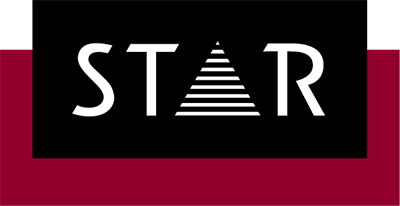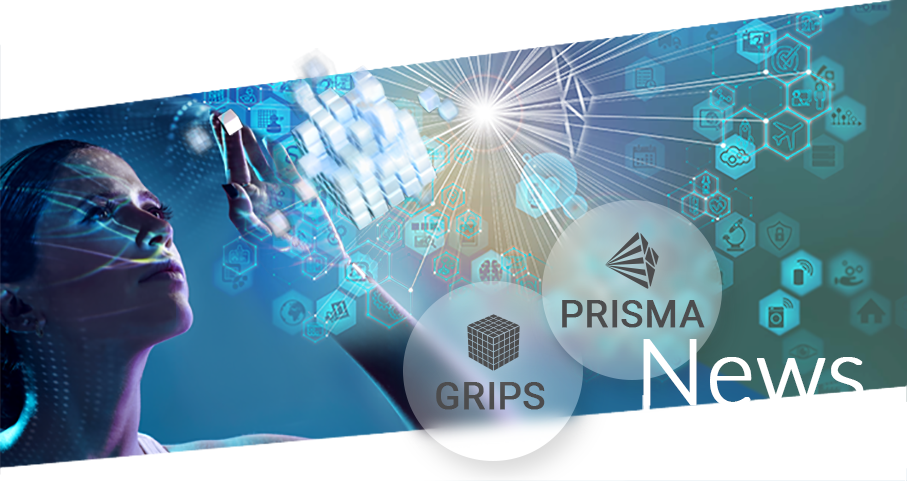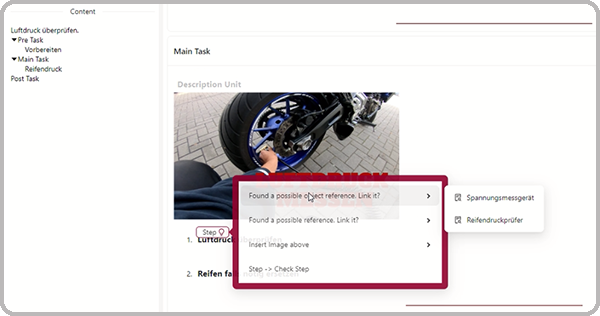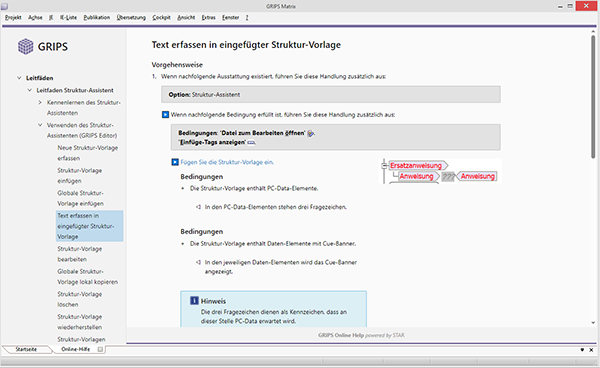At a glance
This newsletter reports on the successful conclusion of the Smart Knowledge Capture innovation project and the highly promising progress of Roadmap 2023–2025. Plus, as always, you will receive the Release Notes for the new GRIPS release.
Results of the Smart Knowledge Capture (SKC) innovation project
Since early 2022, we have reported regularly on our collaboration with the Eastern Switzerland University of Applied Sciences (OST). As part of the Smart Knowledge Capture (SKC) project, approaches were developed for a smart, simple, and fast way to gather product information with the support of AI. The project work has now been completed successfully.
The most important findings:
AI assistance
Interactive AI support when recording GRIPS information units (IUs) is feasible and allows GRIPS newcomers to get started faster. An example from the editor prototype shows how GRIPS displays context-specific suggestions for reuse during the writing process.
The AI finds appropriate IUs for the context and makes it easier to reuse them.
AI assistance thus assumes its role as the "next-generation MindReader" and helps to specify context better and to identify link destinations appropriate for each task.
Guided structure capturing
Tests in the editor prototype also investigated how complex structures can be captured even more easily. The screenshot shows how a testing step with result-dependent tasks is recorded in an automatically suggested template.
In the example, the AI has suggested this template because the word "check" is included in the task.
Role of GenAI
The project began in October 2021, using an AI trained by OST itself. Intensive AI expertise is needed to train a model of this kind.
Then, early in 2023, generative AI – primarily through ChatGPT – was introduced to the general public. That gave rise to Large Language Models (LLMs) being evaluated even without special training. Llama 2 13B and Zephyr were tested. Both are straightforward and economical alternatives to ChatGPT and can also be operated in a private cloud to keep customer data within the company.
The question posed for the tests was whether objects with practical relevance (such as tools, materials, etc.) are recognized in the text. The results – particularly with Zephyr – are promising, although the results from ChatGPT and other "high-end LLMs" are still significantly better.
Overall, the Smart Knowledge Capture innovation project yielded many valuable findings and practicable ideas that will shape the further development of GRIPS and PRISMA in the coming years. We thank OST for the constructive collaboration. A first tangible example of using technical approaches from the project is a simple special editor for special-purpose tools, described further below.
Update GRIPS Roadmap 2023–2025
The implementation of Roadmap 2023–2025 is making great progress:
GRIPS Process Control for workflows
The basic functionality for tracking workflow statuses with phases is expected to become available in Q3.
Online Help
Online Help with content from GRIPS operating instructions and guides as modular HTML publications will be rolled out in one of the upcoming releases. The Online Help tab can also be undocked from the GRIPS window and positioned next to the GRIPS Editor, for example, as its own window.
GRIPS Online Help with a table of contents on the GRIPS start page.
Online Help will be continuously expanded with additional functions in the coming years. In this process, we are also happy to take customer feedback into account.
GRIPS Dashboard
For editorial management, statistics on imported, recorded, edited, translated, and reused IUs are important indicators. The new GRIPS Dashboard (available starting mid-2024) makes this data available at a glance and can be called up from the start page.
Pilot version of the GRIPS Dashboard with the most important IU figures and charts.
In the future, customer-specific adjustments to the dashboard will also be possible.
Smart Knowledge Capture – Special editors
Development has begun on web editors for special tasks, implementing findings from the Smart Knowledge Capture innovation project.
An initial special editor, with which special-purpose tools can be recorded in a customer-specific IU, has already been completed for a pilot customer. The editor is opened from the GRIPS Matrix, is built according to cloud-native principles, and uses GRIPS's service-oriented API.
Special editor for special-purpose tools with input fields, an image, and buttons for the most important functions.
Additional special editors are already in development. You will learn more on this topic in the upcoming newsletters. Customer-specific special editors can also be implemented upon request.
Smart Knowledge Capture – New publishing process
A new, additional publishing process for HTML publications, which will supplement the current GRIPS publishing process, is in the conceptual phase.
The new process will publish GRIPS and PRISMA data consistently and also be able to integrate external master data into the publication. In doing so, even technical data using different units of the open QUDT standard can be converted automatically.
With the new process, data from GRIPS, PRISMA, and external systems can be published in a uniform manner and merged at the time of publication. We will present further details in the next newsletter.
For more information:
matthias.gutknecht@star-group.net
GRIPS Release Notes for Version 2023.04 Build 04 – 2024.01 Build 01
The following important improvements are included in the current releases (GRIPS Version 2023.04 Build 04 – 2024.01 Build 01). The releases are currently being delivered to customers and contain bug fixes and improvements for GRIPS Matrix and automation.
General – Presentation of umlauts and special characters improved in automation emails
Automation is a function integrated into the GRIPS Matrix that monitors a defined address range in the GRIPS Matrix or an external directory and triggers further steps whenever changes are detected. All defined automations (defined tasks that are automatically completed) can be timed and triggered repeatedly at a specified interval. Task monitoring and execution are handled by the GRIPS Manager Service. All automations carried out are documented and summarized in a log. Optionally, a summary can be sent by email after each execution. These emails are improved in their presentation starting with GRIPS Version 2024.01 Build 01. As a result, umlauts and other special characters will always be displayed correctly.
GRIPS Matrix – Info Type Editors
For diverse functionalities and to support editorial activities in GRIPS, additional Info Type Editors can be developed and connected. They allow for optimized topic-specific data entry. Available default Info Type Editors are the GRIPS Image Editor and the GRIPS Document Editor. Info Type Editors of this kind can also be displayed using a web browser function within GRIPS as of GRIPS Version 2023.04 Build 04 (see also the section on special editors in the GRIPS Roadmap update above). For the further development of GRIPS, this provides STAR with additional flexibility in configuring the user interface when it comes to data collection by editorial teams.
GRIPS Matrix – Display of dialog data in CSV format
The CSV (Comma-Separated Values) format is a widely used format for displaying and exchanging data using Microsoft® Excel, for example. As of GRIPS Version 2024.01 Build 01, there is now the option in various dialogs (see detailed Release Notes) and in the GRIPS Matrix IU anchor context menu to export the displayed data as a CSV file. With a click on the "Create CSV file..." button, the data is written to a temporary file in the folder
Other improvements, more details and screenshots, as well as bug fixes can be found in the Release Notes. Take a look – it's worth it!
Release Notes
For more information:
matthias.gutknecht@star-group.net
GRIPS feature requests
The following Request for Feature was implemented in the new release:
- Display of dialog data in CSV format
GRIPS & PRISMA @ Events
STAR is participating in the following events:
- NORDIC TECHKOMM: The conference addresses current trends and topics in technical communication. There, STAR will respond to the somewhat provocative question, "AI's Impact on Technical Authoring: Evolution or Extinction?" and shed light on the influence of new GenAI models. The conference will be held on March 6 and 7, 2024, in Stockholm, Sweden.
- Tecom/tekom Drei-Länder-Tagung (three-country conference): The conference focuses on "AI in Technical Communication" and will be held as a workshop. STAR is the main sponsor of the conference and will use a practical example to show how AI can already support the work of technical writers today. The event will take place on June 14, 2024, in Konstanz, Germany.







